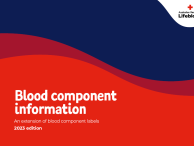Cryoprecipitate is obtained from thawed frozen plasma and is used for patients with fibrinogen deficiency or dysfibrinogenaemia.
Cryoprecipitate is prepared from plasma derived from both whole blood and apheresis donations. Fresh frozen plasma (FFP) is slowly thawed at a temperature between 1–6 ˚C and the resulting cold-insoluble precipitate is removed and then refrozen.
Cryoprecipitate contains most of the factor VIII, fibrinogen, factor XIII, von Willebrand factor and fibronectin found in FFP.
Cryoprecipitate has a shelf life of 12 months when stored at –25º C or below.
One unit of apheresis cryoprecipitate is approximately equivalent to 2.5 units of whole blood-derived cryoprecipitate.
When reviewing international studies of fibrinogen replacement, ensure that the current fibrinogen content in Australian cryoprecipitate is considered when estimating equivalence. Due to differences in manufacturing process between Blood Services internationally, fibrinogen content per 'unit' (pack) and per mL can vary considerably.
Typical unit content and specifications
The typical unit content data is derived from Lifeblood process control testing. For each parameter, the mean value (± 1 SD) and specification is shown.
Unless otherwise specified, data is for the period 1 January to 31 December 2023.
Cryoprecipitate whole blood
| Volume (mL) | 37 ± 2 (30–40) |
| Factor VIIIc (IU/unit) | 152 ± 40 (≥ 70) |
| Fibrinogen (mg/unit) | 372 ± 114 (≥ 140) |
| Von Willebrand factor (IU/unit) | 249 ± 56 (> 100) |
Cryoprecipitate apheresis
| Volume (mL) | 60 ± 2 (54–66) |
| Factor VIIIc (IU/unit) | 396 ± 71 (≥ 70) |
| Fibrinogen (mg/unit) | 1079 ± 299 (≥ 140) |
| Von Willebrand factor (IU/unit) | 666 ± 125 (> 100) |
Availability
Cryoprecipitate is available in all ABO groups. Matching for RhD group is not required.
Modifications
There are no modifications available for cryoprecipitate.


